2016 Yz250f Top Speed

2016 Yamaha YZ250F
Editor Score: 95.0%
Engine 19.0/20 Suspension/Handling 15.0/15 Transmission/Clutch 9.0/10 Brakes 8.0/10 Instruments/Controls 5.0/5 Ergonomics/Comfort 10.0/10 Appearance/Quality 10.0/10 Desirability 10.0/10 Value 9.0/10 Overall Score 95/100
Hop aboard the 2016 Yamaha YZ250F after spending time aboard the 2015 250cc class champion version, and you might find they don't feel much different.
That's a good thing, as the YZ250F has been the bike to beat in the 250cc motocross class over the past two years since Yamaha shocked the troops with a completely redesigned machine that incorporated the fuel-injected, rearward-inclined engine configuration of its big sister, the YZ450F.
Proof of the concept came in the 2014 Lucas Oil AMA 250cc Pro Motocross Championship where young Jeremy Martin ran away with the class title, and currently stands a very good chance of defending it; we'll know how that turns out after the season finale Bud Light Ironman National Motocross in Indiana on August 22. Martin's teammate, Cooper Webb, added to the YZ250F's glory by winning the AMA 250cc West Supercross title this year. Since the bike is a proven winner, Yamaha was understandably in no hurry to reinvent it again, thus for 2015 Yamaha made only minor changes, most notably a new piston, an exhaust cam change to make the little YZ a little easier to start and a modified ECU to give it smoother low-end performance.
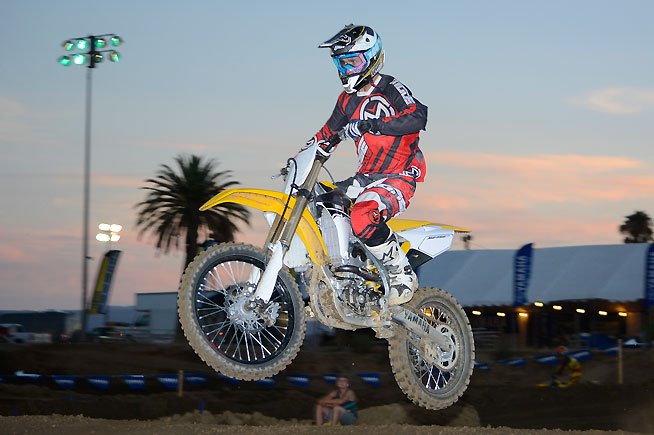
Yamaha invited us to sample the 2016 YZ250F during an afternoon/evening session at Perris Raceway in Southern California.
Which brings us to the 2016 Yamaha YZ250F, a machine that continues along the more conservative path of minor updates to improve the existing design and fine-tune its on-track capabilities. To show us how its quarter-liter screamer has evolved, Yamaha invited is to the legendary Perris Raceway in Southern California, for a late afternoon/evening riding session.
2015 Yamaha YZ250F First Ride Review
Aside from its retro-sexy 60th Anniversary Limited Edition yellow and black photostrobe bodywork and graphics, there is no outwardly visible difference between the 2016 YZ250F and the 2015 model it replaces. Its bilateral beam aluminum chassis is the same. The body panel shapes are the same. Its rearward-inclined engine and mass-centralizing wraparound exhaust system all look the same.

The YZ250F's 249cc, DOHC Single features some key internal changes, including a new piston, new heat treating for the connecting rod and new thrust washers on the big end to increase rigidity and reduce engine vibration. The engine's balance factor has also been changed to help the YZ drive out of corners better.
But delve inside the 2016 YZ250F's 249cc liquid-cooled, DOHC four-stroke Single, and things are not the same. For the second straight year, Yamaha has redesigned the YZ250F's piston. This one features a flatter crown to affect a change in the combustion chamber velocity, and it does away with the sharp edges of the old one, for more efficient filling and scavenging of the mixture. Despite the flatter top, the new piston still maintains the same 13.5:1 compression ratio as the old piston, but look underneath and you will see that its F1-style bridged-box design is completely different, contributing to a 7% weight reduction even while incorporating lateral ribs added to both sides of the wrist pin for greater rigidity. Combining that savings with a lighter piston pin, Yamaha shaved just over 18 grams of top-end weight from the engine. Any high-performance engine builder worth his or her salt will confirm that less top-end weight is always preferable for easier power production and greater reliability at stratospheric rpm.
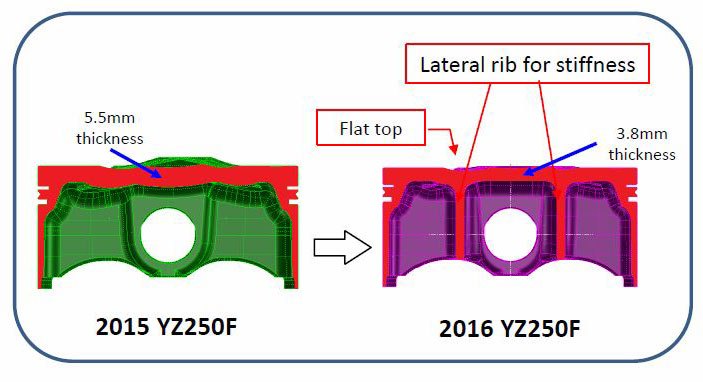
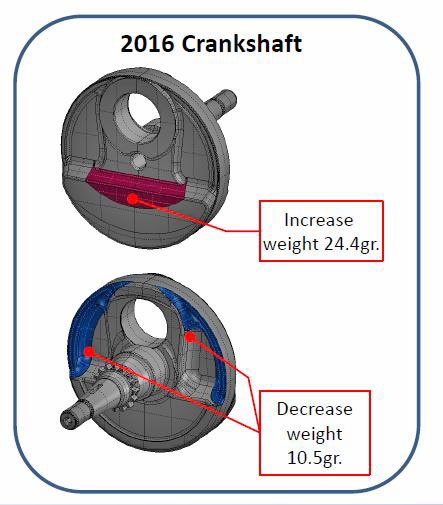
Other engine changes include a new oil spray jet to cool the underside of the YZ250F's piston. The new jet is longer and angled upward for maximum cooling efficiency. Yamaha claims that the new oil spray jet reduces the piston temperature by 50° F when compared to the old design. Also, minor tweaks to the YZ250F's ECU were carried out to lean the fuel delivery from the engine's 44mm Keihin throttle body a little more at low rpm and also to change the intervention pattern of its rev limiter for a less abrupt feeling when the YZ250F hits its 14,000 rpm ceiling.
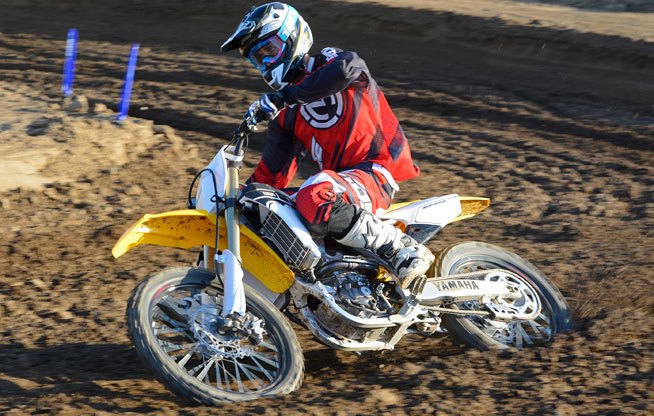
There is a subtle difference in the way that the 2016 YZ250F gets out of corners. The rebalanced engine delivers a shade more tractability for better hook-up when the rider cranks open the throttle.
Our pro-level motocross tester, Ryan Abbatoye spent several laps aboard the YZ250F at Perris, flogging it over jumps, through whoops, and railing the track's rutty corners before coming back and pronouncing that its overall power character simply doesn't feel much different than the 2015. Abbatoye explained that the 2016 YZ250F "feels a little smoother, and it seems to get a little better drive out of corners, but overall I don't think that most people will notice it."
That's hardly a complaint, as broad power is one of the 250F's strong suits. Its 77.0 × 53.6mm bore and stroke deliver clean low-end snap that transitions into a potent midrange and finishes with an authoritative pull on top. There really isn't any place that the stock machine will leave most riders wanting more thrust. It's the kind of engine performance that turns big jumps into small ones and turns the YZ250F's Bridgestone M403 rear tire into a berm shredder.
That said, the YZ250F's power can be tailored in similar fashion to the way it can be done on the Kawasaki KX250F and the Suzuki RM-Z250. While the Kawi and the 'Zook make use of ignition modules to alter the power characteristics, and the Honda CRF250R's ECU can be accessed via a laptop equipped with the proper software, the Yamaha's ECU requires Yamaha's accessory GYTR Power Tuner, but the nifty hand-held device is worth its $291.95 MSRP. The GYTR Power Tuner allows the user to adjust both the fuel and ignition curves individually. Fuel delivery can be adjusted within a 15-step range, with each change, equating to 3% per step for a total of 42% of adjustability. The ignition can be adjusted within a range of 14 steps, with each step changing the ignition timing by 1°, from -9° to +4°. The Power Tuner's memory function can store up to nine custom maps, and its monitor function can keep track of such engine data as rpm, water temperature, air temperature, throttle position sensor and run time, as well as alert the user to various diagnostic codes at service time.
After spinning a load of laps, Abbatoye elected to try out settings created by Yamaha test rider and former AMA Supercross star Travis Preston to give the YZ250F a harder-hitting character that would be ideal for loamy tracks. It only took a minute to adjust the maps, and when Abbatoye returned after another long moto session, he had a grin on his face.
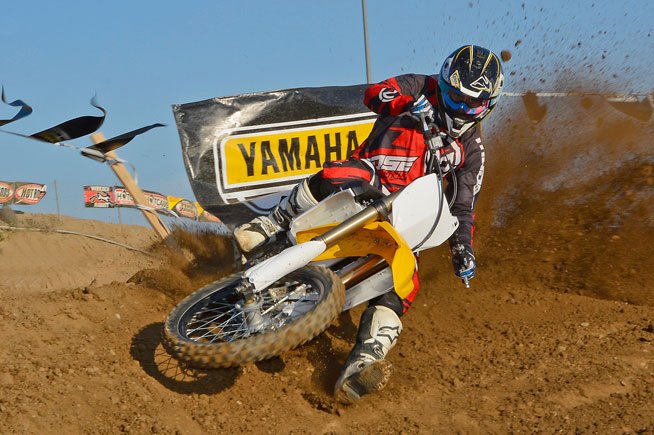
After a couple sessions with the stock-tuned engine, Yamaha remapped our test bike's motor using its accessory GYT Power Tuner. Test rider Ryan Abbatoye noted that the remapped engine is a lot more exciting to ride as it pulls harder through the middle and can hold a gear longer on the top-end.
"It makes a really noticeable difference in the way the power comes on," Abbatoye said. "The engine hits harder now, and it pulls so hard that I could hold each gear longer and still have enough drive to get over jumps that I had to shift to get over before. It's pretty cool."

Here are the settings that Preston recommended.
But even with the changes we made to the mapping, the fact is that you still have to shift the YZ250F – or any 250, for that matter – much more than a 450 in order to keep it churning, and Yamaha has put a lot of work into the 250F's five-speed transmission to make it grab the next gear as smoothly and reliably as possible. To that end, the 2016 gets a new clutch boss and shift-stopper arm designed to improve its clutch engagement feel and shifting action. More transmission changes for 2015 include a redesign of the gear dog corners on third, fourth and fifth gears. The corners are radiused now, rather than chamfered, for smoother engagement.
Overall, our impression of the YZ250F's transmission is the same as it was last year. Yamaha has come a long way in the shifting performance of its motocross machines, as the YZ250F delivers a smooth and positive engagement every time. It's nice that Yamaha made more improvements for 2016, but they aren't drastic. The same goes for the clutch, which has been improved for 2016 via a new machining process that gives the clutch hub a flatter surface to improve clutch plate contact. The clutch judder spring has also been eliminated entirely to give the clutch a more solid engagement feel.
The YZ250's bilateral beam aluminum chassis and KYB suspension have been excellent since their inception on the 2014 YZ250F, but Yamaha has tweaked the suspension slightly to achieve better balance front to back. The YZ250F's fully adjustable Speed-Sensitive System inverted fork features slightly different valving specs this year with a reduction in low-speed compression damping and an increase in high-speed compression damping. It's important to note that Yamaha continues to buck the trend toward air forks, one Yamaha official claiming that the factory has tried them all and still feels that its standard spring fork is better. We would definitely argue that is it just as good, with 12.2 inches of bump-wrangling travel that works well over a variety of track surfaces.

Yamaha engineers borrowed a page from the 2016 YZ450F and fitted the YZ250F with a slightly softer shock spring, which helps to balance the chassis and transfer weight for even better drive out of corners.
Out back, Yamaha addressed an issue that we had with the 2015 YZ250F whereby we felt the need to reduce the rear sag height to aid in weight transfer out of corners. The 2016's fully adjustable KYB now comes from the factory with a slightly softer rear spring rate, 54 Nm versus the 2015's 56 Nm, and Abbatoye duly noted that the new spring instantly makes the 250F feel more at home. Yamaha reduced the spring rate on its 2016 YZ450F with equally positive results.
Speaking of comfort, we're still big fans of the YZ250F's chassis, which is virtually unflappable on rough ground at higher speeds yet can still carve corners like a scalpel. Slim ergonomics and a very flat and narrow seat allow the rider plenty of room to flick the YZ about while putting it anywhere on the racetrack. Mass centralization is the key, as the YZF's 2.0-gallon fuel tank is located under the seat to keep fuel weight lower in the chassis. We also appreciate the design of the top triple clamp, which offers a total of four bar positions for a total of 36mm of adjustment fore and aft.
Braking is another area that Yamaha has addressed. In an effort to give the YZ250F more stopping power, a new 270mm wave rotor front disc is stopped by a two-piston caliper up front. It's a welcome change, although we still think that braking performance is still one area where the 2016 could be improved even more. We're still looking for a bit more bite up front to haul the YZ250F down from speed. Out back, the YZ's 245mm rear rotor and single-piston caliper do a decent job of throwing out the anchors.
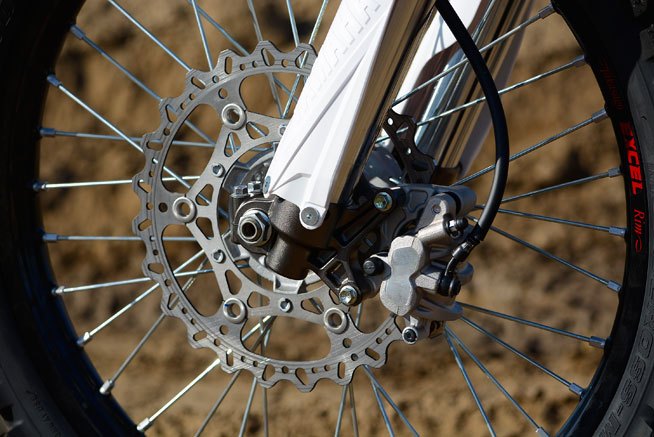
Yamaha got on the 270mm front rotor bandwagon for 2016, although it is still clamped by a two-piston caliper. The new rotor may be 20mm larger in diameter than the previous rotor, but it doesn't feel as if it contributes to any greater stopping power.
Like we said from the beginning, we're big fans of the 2016 model's 60th Anniversary graphics, which recall the glory days of Yamaha factory stars such as Bob Hannah, Broc Glover, Mike Bell and Ricky Burgett. While Yamaha's standard blue and white graphics package looks great, it pales in comparison to the mighty yellow and black photostrobe markings, and we can't imagine anyone not wanting them.
We certainly can't fault the evolutionary path that the YZ250F has taken over the past two years, but that's because we were thrilled with this generation of the bike right from the start, and Yamaha has done nothing to diminish our original stoke. The 2016 YZ250F is the same great 250cc motocross machine that it was in 2014 and 2015, only with a few subtle updates to keep it in the hunt for top 250cc honors. There is a slight price increase over the 2015 model, but the $7590 asking price (add another C-note for the 60th Anniversary colors) is one that we'd pay for a bike of this caliber any day and twice on Sunday.
| 2016 Yamaha YZ250F Specifcations | |
|---|---|
| MSRP | $7590/7690 (60th Anniversary Limited Edition graphics) |
| Engine | Liquid-cooled four-stroke single, DOHC four-valve head |
| Displacement | 249cc |
| Bore x stroke | 77.0 x 53.6mm |
| Compression ratio | 13.5:1 |
| Fuel System | Keihin EFI, 44mm throttle body |
| Ignition | TCI |
| Transmission | Five-speed |
| Final drive | Chain |
| Frame type | Bilateral beam aluminum |
| Front suspension | Inverted KYB fully adj. fork w/Speed Sensitive System; 12.2 in. of travel |
| Rear suspension | KYB fully adjustable monoshock w/piggyback reservoir, 50mm piston; 12.4 in. of travel |
| Front brake | Nissin two-piston caliper 250mm wave-style disc |
| Rear brake | Nissin single-piston caliper 245mm wave-style disc |
| Front tire | Bridgestone M404-A 80/100-21 |
| Rear tire | Bridgestone M403 100/90-19 |
| Wheelbase | 58.1 in. |
| Rake | 27°, 08´ |
| Trail | 118mm |
| Seat height | 38.0 in. |
| Ground clearance | 12.8 in. |
| Wet Weight | 231 lbs. (claimed) |
| Fuel capacity | 2.0 gal. |
| Color choices | Blue & White / 60th Anniversary Limited Edition Yellow & Black |
Source: https://www.motorcycle.com/manufacturer/yamaha/2016-yamaha-yz250f-review.html

Tidak ada komentar: